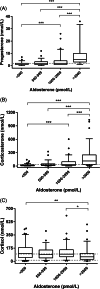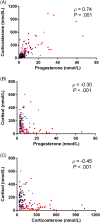Multiple corticosteroid abnormalities in cats with hyperaldosteronism
- PMID: 34331479
- PMCID: PMC8478033
- DOI: 10.1111/jvim.16224
Multiple corticosteroid abnormalities in cats with hyperaldosteronism
Abstract
Background: The frequency with which multiple corticosteroid abnormalities occur in cats with aldosterone secreting adrenocortical tumors is unknown.
Objectives: To evaluate adrenal-derived corticosteroids in cats in which blood samples were submitted for measure of aldosterone.
Animals: Two hundred ninety-seven cats.
Methods: Retrospective study. Analysis of a convenience sample of previously submitted serum or plasma. Progesterone, corticosterone, and cortisol were measured in feline serum or plasma samples submitted to an endocrinology laboratory for aldosterone measurements. Demographics and clinical history were retrieved from submittal forms when provided. Statistical testing was performed to investigate associations among the adrenal corticosteroids.
Results: Progesterone and corticosterone concentrations were strongly correlated (ρ = 0.74; P < .001). Progesterone (median, 5 nmol/L; interquartile range, 3-10 nmol/L) and corticosterone (113 nmol/L, 38-250 nmol/L) in cats with markedly increased aldosterone concentrations (≥3000 pmol/L) were higher than progesterone (1 nmol/L, 1-2 nmol/L) and corticosterone (12 nmol/L, 3-25 nmol/L) in cats with normal aldosterone concentrations (P < .001 for both comparisons). Progesterone concentrations ≥10 nmol/L (normal, ≤2 nmol//L) occurred in 24 of 76 (32%) cats with aldosterone concentrations ≥3000 pmol/L. Cortisol was lower in cats with aldosterone concentrations ≥3000 pmol/L as compared to those with aldosterone concentrations <500 pmol/L (59 nmol/L, 27-103 nmol/L vs 103 nmol/L, 49-182 nmol/L; P = .002).
Conclusions and clinical importance: Multiple corticosteroid abnormalities occur in a subset of cats with hyperaldosteronism. The magnitude of increases in progesterone and corticosterone in some cats with hyperaldosteronism is likely to be clinically relevant.
Keywords: adrenal cancer; corticosterone; cortisol; progesterone.
© 2021 The Authors. Journal of Veterinary Internal Medicine published by Wiley Periodicals LLC on behalf of American College of Veterinary Internal Medicine.
Conflict of interest statement
The hormone assays were performed at the Michigan State University Veterinary Diagnostic Laboratory, which offers commercial veterinary endocrinology testing. The university was not involved in review of this manuscript. No authors have a conflict of interest.
Figures


Similar articles
-
Retrospective study of aldosterone and progesterone secreting adrenal tumors in 10 cats.J Vet Intern Med. 2021 Sep;35(5):2159-2166. doi: 10.1111/jvim.16256. Epub 2021 Sep 2. J Vet Intern Med. 2021. PMID: 34473866 Free PMC article.
-
Serum aldosterone and cortisol concentrations before and after suppression with fludrocortisone in cats: a pilot study.J Vet Diagn Invest. 2015 May;27(3):361-8. doi: 10.1177/1040638715583530. Epub 2015 Apr 21. J Vet Diagn Invest. 2015. PMID: 25901003 Clinical Trial.
-
Longitudinal study of progestins, mineralocorticoids, and glucocorticoids throughout human pregnancy.J Clin Endocrinol Metab. 1989 May;68(5):863-8. doi: 10.1210/jcem-68-5-863. J Clin Endocrinol Metab. 1989. PMID: 2715289
-
Primary Hyperaldosteronism in Cats: An Underdiagnosed Disorder.Vet Clin North Am Small Anim Pract. 2020 Sep;50(5):1053-1063. doi: 10.1016/j.cvsm.2020.05.007. Epub 2020 Jul 8. Vet Clin North Am Small Anim Pract. 2020. PMID: 32653266 Review.
-
THE ADRENAL CORTEX AND REPRODUCTIVE FUNCTIONS.Mod Trends Hum Reprod Physiol. 1963;15:122-54. Mod Trends Hum Reprod Physiol. 1963. PMID: 14115150 Review. No abstract available.
Cited by
-
Surgical findings and outcomes after unilateral adrenalectomy for primary hyperaldosteronism in cats: a multi-institutional retrospective study.J Feline Med Surg. 2023 Jan;25(1):1098612X221135124. doi: 10.1177/1098612X221135124. J Feline Med Surg. 2023. PMID: 36706013 Free PMC article.
-
Determination of Multi-Steroid Profiles of Cats With Hyperaldosteronism or Other Diseases: A Retrospective Study.J Vet Intern Med. 2025 Sep-Oct;39(5):e70209. doi: 10.1111/jvim.70209. J Vet Intern Med. 2025. PMID: 40813337 Free PMC article.
-
Chronic unpredictable mild stress increases serum aldosterone without affecting corticosterone levels and induces hepatic steatosis and renal injury in young adult male rats.J Mol Histol. 2024 Jun;55(3):265-278. doi: 10.1007/s10735-024-10188-3. Epub 2024 Apr 7. J Mol Histol. 2024. PMID: 38583123
-
Case report: Androgen-secreting adrenocortical tumors in eight cats.Front Vet Sci. 2023 Jun 13;10:1158142. doi: 10.3389/fvets.2023.1158142. eCollection 2023. Front Vet Sci. 2023. PMID: 37383353 Free PMC article.
-
Retrospective study of aldosterone and progesterone secreting adrenal tumors in 10 cats.J Vet Intern Med. 2021 Sep;35(5):2159-2166. doi: 10.1111/jvim.16256. Epub 2021 Sep 2. J Vet Intern Med. 2021. PMID: 34473866 Free PMC article.
References
-
- Schulman RL. Feline primary hyperaldosteronism. Vet Clin North Am Small Anim Pract. 2010;40:353‐359. - PubMed
-
- Harvey AM, Refsal KR. Feline hyperaldosteronism. In: Mooney CT, Peterson ME, eds. BSAVA Manual of Canine and Feline Endocrinology. 4th ed.Glouchester, UK: BSAVA; 2012:204‐214.
-
- Chiaramonte D, Greco DS. Feline adrenal disorders. Clin Tech Small Anim Pract. 2007;22:26‐31. - PubMed
MeSH terms
Substances
LinkOut - more resources
Full Text Sources
Miscellaneous

